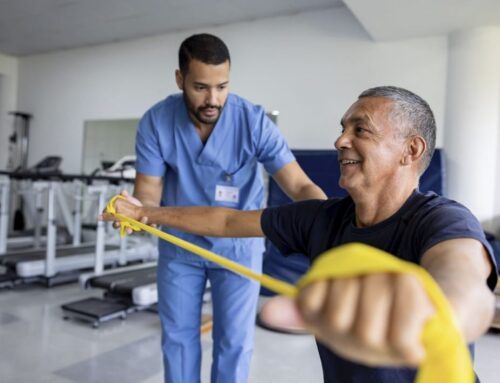The key to building stronger bones and better balance, combating osteoporosis, staying independent and living longer may be as simple as adding strength training to your exercise routine.
When people hear “strength training,” Hulk Hogan and Rocky may come to mind. While these men regularly exercise and lift weights, strength training for seniors is a bit different. (Though choosing your own theme song is allowed!)
This article will discuss why strength training matters significantly as you age, the benefits of strength training and safe ways for seniors to begin strength training.
What is strength training?
Strength training, or resistance training, is not professional bodybuilding. It involves simple exercises that use resistance – like free weights, machines, resistance bands or your body weight – to build muscle and strengthen bones.
Why seniors should strength train
As we age, our bodies change. Our skin gets looser and wrinklier, our eyesight changes, and we lose bone density and muscle mass. Unfortunately, all this is normal.
Starting at age 30, adults begin to experience sarcopenia, the progressive loss of muscle mass and function. We lose about three to five percent of muscle each decade afterward.
Muscle loss limits seniors’ lives and can put them in harm’s way. Sarcopenia can lead to falls, osteoporosis fractures, loss of independence, decreased ability to do what you love and more. It can even result in the need for long-term care.
Natural bone loss speeds up around 50 years of age, especially in women in menopause. Decreased bone density or osteoporosis leads to increased fractures in older adults.
Strength training can help rebuild both bones and muscles impacted by age-related loss. The CDC recommends 150 minutes of moderate aerobic exercise for people over 60. It recommends performing weight training exercises at least two days a week.
The benefits of strength training
Strength training offers many documented benefits for everyone, but especially for seniors.
- Slows bone loss and strengthens your bones
This is especially helpful in combatting age-related bone loss and preventing osteoporosis-related fractures. The tugging, pushing and weight-bearing aspects of weight training and aerobic exercise encourage bone-creating cells to work, making your bones stronger.
- Keeps your heart and brain healthy
Regular physical activity can reduce your risk of developing Alzheimer’s disease, slow cognitive decline and prevent heart disease or stroke. It also helps maintain memory, attention and concentration.
- Lowers your risk of injury
As muscles grow with strength training, your balance and stability are enhanced, lowering the risk of falls. Strength training particularly develops the bones, ligaments and tendons in joints most likely to fracture – specifically hips, wrists and spine.
- Builds muscle, which burns more calories, making it easier to keep a healthy weight
When you build muscle, your body needs more calories to sustain them. Your body uses more calories, which can result in weight loss and decreased pressure on your joints. Be careful not to eat more just because you are strength training.
- Strengthens your back muscles and your posture
Older people can develop poor posture and a stoop from weak back and core (abdominal) muscles. This stoop, called an accentuated thoracic curvature of the spine, places pressure on the lungs, lowering their capacity. It also limits your ability to breathe deeply and can impact balance.
- Helps people remain independent and live longer lives
A 2022 study showed that regular muscle-strengthening activities linked to a 10 to 17 percent lower risk of death. Weak muscles and bones make it hard to do everyday tasks like bathing, using the bathroom, grocery shopping and doing laundry.
No one wants limitations during their golden years. Let’s look into how you can reduce muscle and bone loss by incorporating strength training into your routine.
How to begin strength training
Talk to your doctor
Cary Orthopaedics recommends talking with your doctor before beginning a training program. This is not a mere formality but an opportunity to discuss any concerns you may have about your overall health. Your doctor can give tips on how to begin and make a referral to a physical therapist.
Physical therapists specialize in creating custom exercise programs for people to strengthen their muscles and joints, especially after an illness, atrophy, injury or medical procedure. They teach proper form and techniques to work muscles safely and prevent injuries.
You can also ask for a referral to a personal trainer who has experience working with mature adults.
Learn proper exercise form
Whether you work with your doctor, a personal trainer or a physical therapist, it is important to use proper form and technique when lifting weights. Improper technique can cause injuries.
Do not search for YouTube videos and start without learning the proper weight-lifting form. This can lead to injuries.
Warm up
Getting your muscles warm before weightlifting is important as well. Warming up loosens your muscles and prepares them to work. Light aerobic exercise like a brisk walk, riding an exercise bike or some modified jumping jacks (jacks without the jump) are good ways to warm up.
Cold muscles are more prone to injury, so warm up for five to 10 minutes before beginning your strength training workout.
Choose the appropriate weight or resistance
Select the right weight or resistance band for your exercises by starting with light weights and moving gradually to heavier ones.
Try to perform each of your strength training exercises in sets. Sets are groups of exercises done at the same time.
To begin, start with light weights or a resistance band. Perform the exercise, like a bicep curl, for eight to 12 repetitions. Take a short break for 30 seconds to two minutes, then do another eight to 12 reps. Try to do at least two sets.
By the end of your set, it should be hard to complete the exercise. If it is not hard, increase your weight or resistance. If it is too hard to complete eight repetitions, then work with a lighter weight or resistance band until it becomes easier.
Generally, you will see results after four to six weeks of consistent strength training.
Breathe and listen to your body
Holding your breath while exercising can cause you to pass out or injure yourself. Be sure you are breathing correctly, as your doctor, therapist or trainer instructs.
Finally, listen to your body. If the weight seems too heavy today, don’t use it even if you used it yesterday without a problem. Bodies heal more slowly as they age, so give your body at least 48 hours between training workouts.
You should have some soreness when you begin or after moving to a heavier weight, but it should not be crippling. If you have significant pain, speak with your doctor because you may have caused an injury.
Start your strength training program today!
At Cary Orthopaedics, we encourage seniors to add strength training to their exercise routines. While cardiovascular exercise is valuable and important, the benefits of strength training offer seniors the best quality of life.
Our physical therapists are specially trained to create exercise plans and teach seniors the best muscle-strengthening exercises for their specific needs. Contact us today to learn more!






